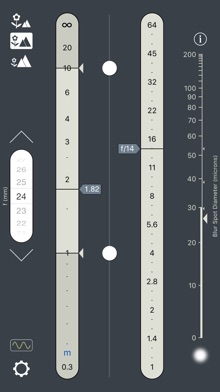Introduction to OptimumCS-Pro
-
✓Easily find the settings that give maximum image sharpness for the shot you’ve composed.
-
✓Know how sharp it will be before you’ve even shot it.
-
✓Use info on image sharpness to make creative decisions to shoot at other than optimal settings.
-
✓Enjoy the fastest, most intuitive operation imaginable.
-
✓Feel confident knowing that’s it’s all based on solid, empirically tested optical science.
Creating sharp images of scenes that extend from near to far entails, above all else, choosing the optimum focus distance and aperture.
If we shoot at too wide an aperture, we lose image resolution due to defocus blur (the blurring of objects in front of and behind our focus distance); at too narrow an aperture, we lose out due to diffraction. So we need to know what the optimum aperture is. And the optimum focus distance. OptimumCS-Pro gives us what we need.
If we want to achieve the highest quality results, we cannot rely on standard practice.
From Carl Zeiss, one of the world’s most respected lens makers:
-
•The international depth of field standard, the basis for all camera lens manufacturers to calculate their depth of field scales . . . dates back from a time when image quality was severely limited by the films available.
-
•Those who use depth of field scales . . . and formulas (e. g. for hyperfocal settings), restrict themselves – most probably without knowing why – to the image quality potential of an average pre-World-War-II emulsion.
(Camera Lens News No. 1, http://www.zeiss.com/cln)
Back before World War II, film was frightfully slow and most photographs were printed quite small. The question, back then, was this: What is the largest aperture that will give me sufficient sharpness on a typically small print? Notice that this is all about achieving minimally acceptable sharpness, not the sharpest possible photograph.
And, of course, traditional practice does not take diffraction into account.
Now, OptimumCS-Pro brings things into the modern era.
The difference between the results of traditional practice, and the results of OptimumCS-Pro’s optimal practice, is not a trivial one — you can easily lose half or more of your image sharpness by doing things the old way.
VERY IMPORTANTLY, this app works the way photographers work, so the creative process is a perfectly natural one:
-
1.Compose.
-
2.Decide which is the nearest and which is the furthest element in your photograph that needs to be sharp.
-
3.In OptimumCS-Pro, simply input their distances, along with the focal length of your lens.
That’s all there is to it. OptimumCS-Pro instantly displays the focus distance and aperture that will give you the sharpest possible image, along with an indication of how sharp it will actually be.
In most imaging work, OptimumCS-Pro offers the fastest, most intuitive and most effective way to work with depth of field.
Optimum camera settings are device independent, so OptimumCS-Pro is universally applicable.
OptimumCS-Pro displays image sharpness information, so the user knows how sharp the image will be before it's shot. Also included is data on shooting at other than optimal settings. Can’t shoot at the optimum aperture, because, for example, you need a faster shutter speed afforded by a wider aperture? You’ll know exactly what the effect of your decisions will be.
While the interface remains elegant and uncluttered OptimumCS-Pro includes options to configure that interface to better meet individual professional needs:
-
•Several different distance scales, emphasising near or far distances, are available, as is one for use with Hansma’s focus shift method in large format photography (and film/sensor sizes all the way up to 8x10 inch are accommodated).
-
•Information on image sharpness can be displayed in terms of blur spot diameter (akin to circle of confusion, but with the effects of diffraction included) or in line pairs per mm.
OptimumCS-Pro is for all imaging professionals. It's intuitive operation and instant results are perfect for creative professionals who don’t want their tools to get in the way of their work or their art.
Think that, perhaps, a depth of field calculator, such as TrueDoF-Pro, might better meet your needs? See Best Practice in Working with Depth of Field.

OptimumCS-Pro
TrueDoF-Pro
FocusStacker
For screen shots, showing how this app appears on your chosen device, go to the
OptimumCS-Pro is the unique Optimum Camera Settings tool for imaging professionals - for cinematographers, videographers and photographers. As a professional, you spend a fortune on quality optics; OptimumCS-Pro helps you use that gear to its full potential.




